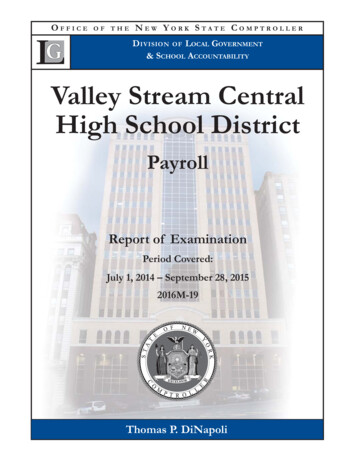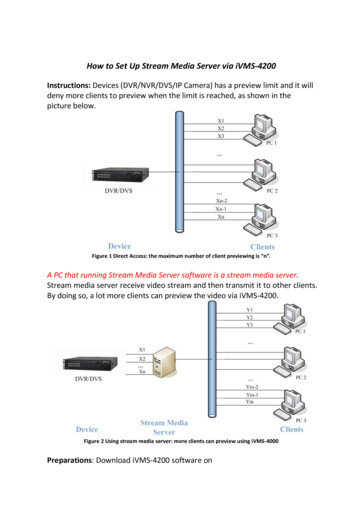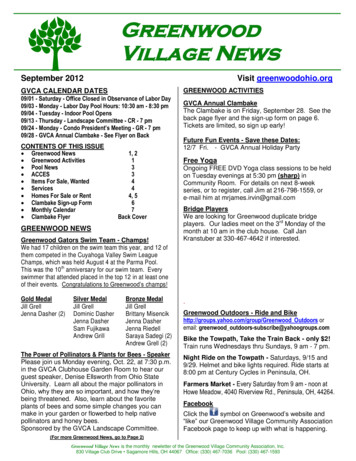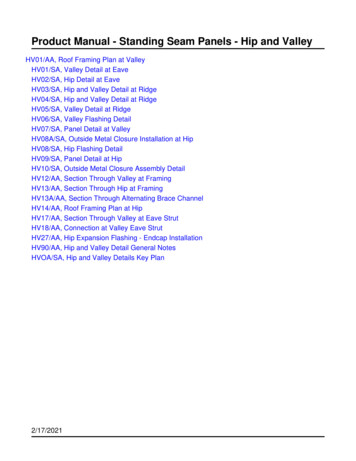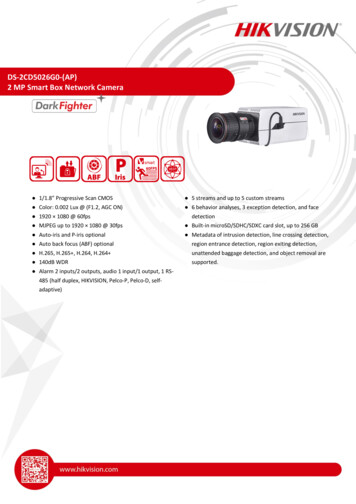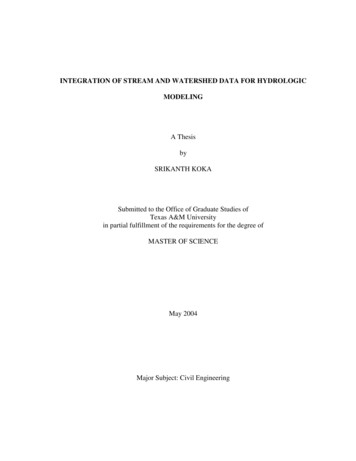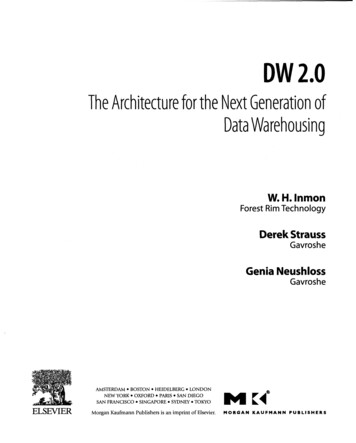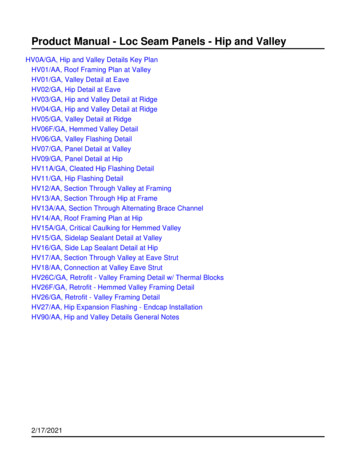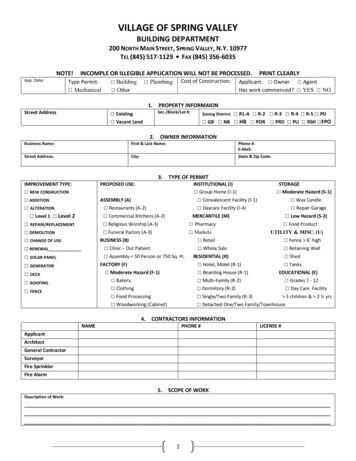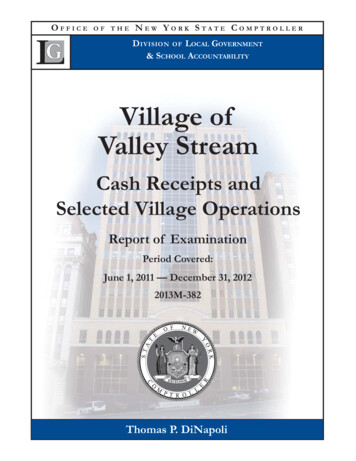
Transcription
OFFICEOF THENEW YORK STATE COMPTROLLERD IVISION OF LOCAL GOVERNMENT& SCHOOL ACCOUNTABILITYVillage ofValley StreamCash Receipts andSelected Village OperationsReport of ExaminationPeriod Covered:June 1, 2011 — December 31, 20122013M-382Thomas P. DiNapoli
Table of ContentsPageAUTHORITY LETTER2EXECUTIVE SUMMARY3INTRODUCTIONBackgroundObjectiveScope and MethodologyComments of Local Officials and Corrective Action55556CASH RECEIPTSVillage PoolClerk’s OfficeMetered ParkingVillage LibraryRecommendations779101213AUDIT AND PAYMENT OF CLAIMSAudit of ClaimsPayment of DIXAPPENDIX17202223ABCDResponse From Local OfficialsAudit Methodology and StandardsHow to Obtain Additional Copies of the ReportLocal Regional Office ListingDIVISION OF LOCAL GOVERNMENT AND SCHOOL ACCOUNTABILITY11
State of New YorkOffice of the State ComptrollerDivision of Local Governmentand School AccountabilityApril 2014Dear Village Officials:A top priority of the Office of the State Comptroller is to help local government officials managegovernment resources efficiently and effectively and, by so doing, provide accountability for taxdollars spent to support government operations. The Comptroller oversees the fiscal affairs of localgovernments statewide, as well as compliance with relevant statutes and observance of good businesspractices. This fiscal oversight is accomplished, in part, through our audits, which identify opportunitiesfor improving operations and Village Board governance. Audits also can identify strategies to reducecosts and to strengthen controls intended to safeguard local government assets.Following is a report of our audit of the Village of Valley Stream, entitled Cash Receipts and SelectedVillage Operations. This audit was conducted pursuant to Article V, Section 1 of the State Constitutionand the State Comptroller’s authority as set forth in Article 3 of the General Municipal Law.This audit’s results and recommendations are resources for local government officials to use ineffectively managing operations and in meeting the expectations of their constituents. If you havequestions about this report, please feel free to contact the local regional office for your county, as listedat the end of this report.Respectfully submitted,Office of the State ComptrollerDivision of Local Governmentand School Accountability2OFFICE OF THE NEW YORK STATE COMPTROLLER
State of New YorkOffice of the State ComptrollerEXECUTIVE SUMMARYThe Village of Valley Stream (Village) is located in the Town of Hempstead, Nassau County. TheVillage is governed by an elected Board of Trustees (Board) comprising the Village Mayor (Mayor)and four Trustees. The Board is responsible for the Village’s overall financial management, includingestablishing appropriate internal controls over financial operations. The Village Library is governed bya separate, elected Board of Trustees (Library Board). The five-member Library Board is responsiblefor establishing appropriate controls over the Library’s financial operations. The Treasurer is the chieffiscal officer and custodian of all Village and Library money.The Village’s general fund expenditures totaled approximately 34.3 million for fiscal year 201011 and 35.9 million for the 2011-12 fiscal year. The Village’s Library fund expenditures totaledapproximately 1.3 million for fiscal year 2010-11 and 1.4 million for fiscal year 2011-12.Scope and ObjectiveThe objective of our audit was to review internal controls over selected Village operations for theperiod June 1, 2011 through December 31, 2012. Our audit addressed the following related questions: Are controls over cash receipts properly designed to ensure that Village resources aresafeguarded and properly accounted for? Are claims audited by the Board and paid in accordance with Village Law?Audit ResultsWe identified weaknesses in the cash collection procedures in the Village’s Recreation Department,Clerk’s office, Highway Department and Library. Neither the Board nor the Library Board adoptedcash receipts policies to secure cash resources. We found discrepancies at the Village pool betweenamounts collected, recorded and deposited, which were not investigated or reported to the Treasurer.For example, 21 logged pool admissions, totaling 7,284, did not reconcile with their correspondingregister tapes. In the Village Clerk’s office, employees issued manual receipts during times of highvolume, which were not reconciled with computer-generated receipts collected by the Treasurer.As a result, 46 manually issued receipts for parking permits, totaling 7,040, could not be located.Although the deposit of this money was supported by bank statements and deposit slips, without areconciliation of manual and computerized receipts, there is an increased risk of error, loss or theft.Further, employees from the Highway Department collect coins from unsecured street parking meterswithout supervision, and some of the coins collected are not deposited immediately after a count isDIVISION OF LOCAL GOVERNMENT AND SCHOOL ACCOUNTABILITY33
made. Meter collections were sometimes skipped for periods of two to three weeks, and some of thiscash was deposited between 14 and 26 days after being collected and counted. Finally, cashiers atthe Village Library do not issue duplicate press-numbered receipts when collecting cash, and moneycollected by multiple cashiers is stored in an unlocked common cash drawer, without a cash countbefore and after a change of cashiers. The insufficient controls over the cash collection, recording,reconciliation and deposit processes increases the risk of errors and irregularities occurring withoutbeing detected and corrected.We also found that neither the Board nor Library Board audits and approves claims for payment.Instead, the Village Treasurer and his staff audit all claims against the Village and the Library. Wefound deficiencies in 20 claims totaling 140,174 (73 percent of the dollar amount of our test), suchas the lack of reviewer signatures and the use of confirming purchase orders with no prior approvals.Further, checks are signed electronically with the Mayor’s and a Village Trustee’s facsimile signature,but neither official retains custody of the signature file or is present during the affixing of theirsignatures. This arrangement is contrary to Village Law. The Village and Library Boards may notdelegate their responsibilities to audit and approve claims for payment to the Treasurer and his staff.Likewise, the Board may not assume the power of the Treasurer, as custodian of Village funds, anddelegate that responsibility to the Mayor and a member of its Board. As a result of these practices,there is an increased risk of unauthorized purchases and claims being inappropriately paid.Comments of Local OfficialsThe results of our audit and recommendations have been discussed with Village officials and theircomments, which appear in Appendix A, have been considered in preparing this report. Villageofficials generally agreed with our findings and recommendations and indicated they have taken, orplan to take, corrective action.4OFFICE OF THE NEW YORK STATE COMPTROLLER
IntroductionBackgroundThe Village of Valley Stream (Village) is located in the Town ofHempstead, Nassau County, and has a population of approximately36,000. The Village is governed by an elected Board of Trustees(Board) comprising the Village Mayor (Mayor) and four Trustees. TheBoard is responsible for the Village’s overall financial management,including establishing appropriate internal controls over financialoperations. The Mayor and other administrative staff are responsiblefor overseeing and managing the Village’s daily operations. TheTreasurer is the chief fiscal officer and custodian of Village fundsincluding Village Library funds; is responsible for maintaininga record of all receipts, expenditures and account balances; and isresponsible for providing the Board with timely, accurate and usefulfinancial information.The Village Library is subsidized by the Village’s general fund.The Library’s expenditures totaled approximately 1.3 million forthe 2010-11 fiscal year and 1.4 million for the 2011-12 fiscal year.It is governed by a separately elected Board of Trustees (LibraryBoard) comprising five Trustees. The Library Board is responsiblefor establishing appropriate controls over the Library’s financialoperations. An appointed Library Director is responsible foroverseeing and managing the Library’s daily operations.The Village employs 160 full-time, 215 part-time and 200 seasonalemployees. It provides services including public works, a justicecourt, building code enforcement, and cultural and recreationalactivities. These services are funded primarily with revenues fromreal property taxes and departmental income. The Village’s generalfund expenditures totaled approximately 34.3 million for fiscal year2010-11 and 35.9 million for fiscal year 2011-12.ObjectiveScope andMethodologyThe objective of our audit was to review internal controls overselected Village operations. Our audit addressed the following relatedquestions: Are controls over cash receipts properly designed to ensurethat Village resources are safeguarded and properly accountedfor? Are claims audited by the Board and paid in accordance withVillage Law?We examined internal controls over cash receipts and the audit ofclaims for the period of June 1, 2011 through December 31, 2012.DIVISION OF LOCAL GOVERNMENT AND SCHOOL ACCOUNTABILITY55
We conducted our audit in accordance with generally acceptedgovernment auditing standards (GAGAS). More information onsuch standards and the methodology used in performing this audit isincluded in Appendix B of this report.Comments ofLocal Officials andCorrective ActionThe results of our audit and recommendations have been discussedwith Village officials and their comments, which appear in AppendixA, have been considered in preparing this report. Village officialsgenerally agreed with our findings and recommendations andindicated they have taken, or plan to take, corrective action.The Village Board has the responsibility to initiate corrective action.A written corrective action plan (CAP) that addresses the findings andrecommendations in this report should be prepared and forwardedto our office within 90 days, pursuant to Section 35 of the GeneralMunicipal Law. For more information on preparing and filing yourCAP, please refer to our brochure, Responding to an OSC AuditReport, which you received with the draft audit report. We encouragethe Board to make this plan available for public review in the VillageClerk’s office.6OFFICE OF THE NEW YORK STATE COMPTROLLER
Cash ReceiptsThe Board is responsible for establishing internal controls so thatcash is safeguarded, accounted for and properly recorded. Suchcontrols include written policies over the cash receiving function.Accordingly, Village officials are responsible for designing anddocumenting appropriate operating practices and procedures anddelineating employee responsibilities. Procedures should provide forindividual accountability and ensure that cash receipts are properlysecured, accounted for, recorded and deposited. Since the Library hasa separate board, the Board is required to adopt a system of internalcontrols over Library cash receipts. Village Law requires the Treasurerto deposit Village money within 10 days after receipt.The Board and Library Board have not adopted cash receiptspolicies requiring internal control procedures to be establishedand implemented. We identified weaknesses in the cash collectionprocedures at the Recreation Department, Clerk’s office, HighwayDepartment and Library. Management and employees developedcash collection procedures that were not consistent with good internalcontrol practices, resulting in errors in recording and reporting cashreceipts, without management questioning the errors or re-evaluatingprocedures. As a result, Village officials do not have adequateassurance that all cash collected has been properly recorded andaccounted for.Village PoolEffective internal controls require that cashiers’ access to the cashdrawer be limited to sales transactions, with refunds and “no-sale”1transactions requiring supervisory approval. Cash collections shouldbe reconciled to the register tapes and any differences investigated,resolved and reported to the Treasurer.The Board did not establish written policies and Village officials didnot establish written procedures covering pool receipts. Discrepanciesbetween the cash register tapes, manually maintained admissionlogs, cash collections and deposits were not investigated or reported,and explanations for transaction errors were not documented.Consequently, Village officials have no assurance that all cash registerreceipts at the Village pool have been properly accounted for.Pool patrons pay a different admission fee based on whether they aremembers or guests. The admission price is further divided by adult,1In a no-sale transaction, the cash register drawer is opened but there is nodocumentation to indicate whether anything was added to or removed from theregister.DIVISION OF LOCAL GOVERNMENT AND SCHOOL ACCOUNTABILITY77
child or senior citizen. Fees range from 7 to 12. A common cashregister is used to collect pool fees; the cash drawer is reconciled atthe end of each shift, up to four times a day.2 In addition to collectingadmission fees, the cashier records the patrons’ names, identificationnumbers and amounts paid in the pool admission log. At the end ofeach shift, the cashier and the supervisor close out the register, generatea close-out report,3 count the cash in the drawer and compare the cashtotal to the total fees recorded on the admission log for that shift. Thesupervisor attaches the close-out report and cash to the admissionlog and records the total from each close-out report and admissionlog, as well as the cash on hand, on the back of the admission log,then submits the tape, log and cash to the Recreation Departmentoffice. The Recreation attendant prepares a daily summary of totaladmissions and total cash collected by each cashier. The cash receiptsare stored in a safe in the Recreation office until the end of the week.The attendant summarizes the daily reports in a weekly receiptssummary report which, along with the total cash collected and thedaily report summaries, is provided to the Treasurer’s office at theend of each week for processing and deposit.Reconciliations — During our audit period, the Village collected 660,047 in pool admission fees from Village residents and theirguests. We selected receipts for 29 days4 comprising 53 register closeouts, totaling 14,676, to determine whether pool receipts have beenproperly accounted for.Cash register tapes were either lost or destroyed for three admissionlogs totaling 2,287. Therefore, Village officials have no assurancethat reconciliations were performed for these admission logs or thatthese receipts were properly recorded and deposited.Of the remaining 50 admission logs, 29 logs totaling 5,105 reconciledwith the register tapes. The remaining 21 logs, totaling 7,284, didnot reconcile with their corresponding register tapes; 12 admissionlogs showed less receipts than the register tapes by a total of 327,and nine admission logs exceeded the register tapes by a total of 65.We found no documentation to explain the nature of the discrepanciesor indicate that they were reported to the Treasurer for further review.Additionally, 39 admission logs included transactions of multiplecashiers on the same register drawer. Further, cashiers were allowedto process refunds totaling 706. These undocumented refunds, along2348The timing and number of shifts vary daily due to weather, pool activity andavailability of pool staff.The close-out report, also called the “Z-tape” report, lists a summary of all cashregister transactions within the current shift just completed.To test cash receipts collected at the pool, we selected pool receipts includedin the first deposit made in the months of June and August 2011 and July andAugust 2012.OFFICE OF THE NEW YORK STATE COMPTROLLER
with 444 instances of no-sale transactions, were performed withoutsupervisory review and approval.Daily Reports — For these same 29 days of cash receipts, we alsocompared the register tapes and admission logs to the daily reportssubmitted to the Treasurer and identified numerous discrepancies: Thirty-eight admission logs totaling 12,503 differed fromcorresponding daily reports to the Treasurer; 13 logs totaledmore than the respective daily reports by 133, and 25 logstotaled less than the respective daily reports by 120. Thirty-seven register tapes totaling 11,101 did not matchtheir corresponding daily reports; 18 register tapes totaledmore than the respective daily reports by 118, and 19 registertapes totaled less than the respective daily reports by 285. In over 500 instances (including 37 tapes mentioned above),the patron classifications recorded on the register tape differedfrom those on the daily report, equating to a gross total of 4,582. Most of these differences were not realized becausethe overages were canceled out by the shortages; however,none of these differences were reported to the Treasurer sothat the errors could be addressed and future errors prevented.The attendant told us that she uses the admission logs to determinethe classification of patrons based on the amount paid per transaction,which she uses to develop the daily summary of admissions. However,the admission logs do not identify transactions based on the type ofpatron, and, because the fees vary, the patron classifications cannotbe consistently determined for payments covering multiple types ofpatrons.These discrepancies occurred because there was a lack of effectivecontrols and procedures to ensure accountability and properreconciliation of the cash collected with the amounts recorded. As aresult, there is an increased risk of errors or irregularities occurringwithout detection and correction.Clerk’s OfficeVillage officials are responsible for ensuring that personnel in theClerk’s office account for all duplicate receipts, properly recordall receipts issued in a cash receipts journal, retain copies of thosereceipts and periodically compare them to the amounts recorded inthe cash receipts journal. Duplicate receipts should provide sufficientdetail to reconcile with the Village’s record. An adequate accountingsystem provides a way to follow issued receipts through the processof collecting, recording and depositing.DIVISION OF LOCAL GOVERNMENT AND SCHOOL ACCOUNTABILITY99
Cash receipt transactions processed in the Clerk’s office are generallyhandled by a computer system that generates a duplicate receiptand records the transactions in the accounting records. However,to expedite the process during high-volume periods, staff manuallyprepare and issue two-ply pre-numbered receipts (“manual receipts”)to process certain transactions such as issuing parking permits. Inthose instances, a manual receipt is issued to document and accountfor the cash received, and later in the day the manual receipts areentered into the computer system. Cash collected is stored in eachemployee’s desk drawer. This process results in dual, differentlynumbered receipts issued for the same transaction. At the end of theday, the Treasurer collects the cash from the staff but does not collectthe manual receipts or reconcile them with the computer-generatedreceipts. Without such reconciliation, there is no assurance thatall manual receipts have been entered into the system and that allcash collections have been properly accounted for, remitted to theTreasurer and deposited.During the audit period, the Clerk’s office collected 332,700 incash. We reviewed one week5 of collections totaling 10,456 todetermine whether manual receipts were accounted for, accuratelyrecorded in the computerized system and available to support bankdeposits. Although the amount deposited was supported with depositslips and bank statements and agreed with the amount recorded inthe computerized system, 46 manually issued receipts for parkingpermits, totaling 7,040, could not be located and therefore werenot available for reconciling to the computer-generated receipts foraccuracy. Moreover, the computerized receipts’ transaction notes didnot reference the corresponding manual receipt numbers. Therefore,Village officials could not conduct a meaningful reconciliation of themanual and computerized cash receipts. Without such a reconciliation,amounts collected and receipted with manual receipts could differfrom computer entries, increasing the risk of error, loss or theft.Because the Board did not adopt written policies and managementdid not develop procedures to ensure accountability for all cashcollected, the Clerk’s office staff developed informal proceduresthat were inconsistent with good internal control practices. Withoutsound controls to ensure that manual receipts are properly accountedfor, Village officials have no assurance that all money collected hasbeen properly accounted for, recorded and deposited.Metered ParkingEffective controls over parking-meter collections should ensureaccountability of each person who collects the money and require510The Treasurer told us that cashiers issue duplicate receipts manually duringhigh-volume periods, such as the month of April when issuing parking passes.Therefore, we selected a week of receipts collected during April 2012 for our test.OFFICE OF THE NEW YORK STATE COMPTROLLER
that each collection is counted upon receipt and deposited promptly.Parking-meter collectors should be rotated frequently, and access toparking-meter coins should be restricted by sealed coin holders or asimilar secured device. When secured coin devices are not practicable,management can implement procedures to mitigate the risk of loss,such as supervised collections and trend analysis6 by route.The Board did not adopt policies ensuring that internal controlsover parking meter collections are well designed, implementedand monitored. As a result, Village officials developed their ownprocedures for retrieving, counting and depositing parking metercollections, which are not adequate to safeguard Village resources.Highway Department employees collect coins from street parkingmeters three times per week. Collections are unsupervised and madeby lone employees along the same predetermined routes. Coinsare collected from unsecured parking meter containers and looselyemptied into zip-locked canvas bags. At the end of the routes, thecoins are comingled and stored in a safe for one to three days untilthey are counted. Generally, on the fourth day the coins are sorted bydenomination, machine counted and placed into sealable bank depositbags based on pre-set dollar amounts. If coins are not sufficientto reach the preset amount, the partially filled bag is retained andcomingled with the following week’s coin collection for deposit.During the audit period, the Village collected 768,750 from parkingmeter collections. We reviewed all 77 coin deposits made during thisperiod and found six instances of meter collections being skipped forperiods ranging from two to three weeks; when collections resumed,this amount aggregated to 101,200 (13 percent of total collections).Of this amount, at least 3,763 of the coins was deposited between14 and 26 days after being collected and counted. In addition, sincecoin collection data was not identified and recorded by route and/or employee, Village officials could not perform any meaningfultrend analysis to mitigate the inherent risk associated with unsecuredparking meter collections.The lack of necessary controls over the collection and deposit ofparking meter coins significantly increases the risk that money couldbe lost, stolen or misappropriated without detection. In addition,without daily, individual counts and deposits, Village officials cannotestablish trend histories for each collection route and perform routineand meaningful analytical review of collection trends.6Trend analysis is a mathematical technique that uses historical data to predictperformance over time.DIVISION OF LOCAL GOVERNMENT AND SCHOOL ACCOUNTABILITY1111
Village LibraryThe Library’s Board and officials are responsible for accounting forand protecting Library assets. Effective controls should include theuse of sequentially numbered duplicate receipts7 issued by Libraryemployees authorized to receive cash, indicating which clerk collectedthe cash, the purpose and form of the payment and the date of thetransaction. Employees who receive cash should each have their ownassigned cash drawer. When cash custody is transferred from oneemployee to another, the receiving employee should count the cash infront of the employee relinquishing it, and both should acknowledgethe count by signing the receipt record. Further, cash on hand shouldbe reconciled with the cashiers’ daily logs. Securing collections in alocked cash register during each cashier’s shift protects collectionsfrom loss or misuse.The Library Board did not develop policies, and officials did notimplement procedures, to properly safeguard Library money. Cashiersdo not issue duplicate press-numbered receipts when collecting cashbut only record the dollar amount and nature of the transaction ina cashier log. The money, collected by multiple cashiers, is storedin an unlocked common cash drawer, without a cash count beforeand after a change of cashiers. Without the issuance of duplicatereceipts, a proper accounting of cash on hand and its reconciliationwith the cashiers’ daily logs is not possible. Library staff identifydiscrepancies (overages and shortages) on daily internal reports butdo not report them to the Treasurer. Instead, discrepancies are nettedand the adjusted amounts are submitted to the Treasurer for deposit.Library cash receipts totaled 50,087 during the audit period. Weselected and tested one month8 of cash receipts totaling 3,381 todetermine if the amounts recorded in the cashiers’ daily logs and thedaily internal reports agreed with the amounts remitted and depositedby the Treasurer. The 3,381 remitted to the Treasurer included 99in cash receipts in excess of the amounts recorded in the daily reports.Due to the lack of duplicate receipts identifying the name, purpose andform of payment received, Library officials are not able to reconcilethe cash received with the daily report and the cash remitted to theTreasurer for deposit.The failure to issue sequentially numbered duplicate receipts for allcash collected at the Library, as well as using a common cash drawerand not assigning accountability to individual cashiers, increasesthe risk of cash being lost or stolen. In addition, without accuratelydocumenting, reporting and explaining cash variances, Villageofficials have no assurance that all Library receipts are properlyaccounted for.7812General Municipal Law requires the issuance of consecutively numbered receiptswhen receiving money on behalf of a municipality.We selected all cash receipts posted and deposited during the month of July 2012.OFFICE OF THE NEW YORK STATE COMPTROLLER
Recommendations1. The Board should adopt written policies and Village officialsshould implement written procedures for the acceptance, handlingand recording of departmental cash receipts and supervisoryreview of cash receipts. Procedures should explain how todocument and report cash overages or shortages to the Treasurer.2. Recreation Department managers should ensure that cashcollections at the Village pool are reconciled to register tapes,admission logs and daily reports. Any differences should bereported to the Treasurer, investigated and resolved.3. The Board should require, and Village officials should develop,procedures to ensure that no-sale transactions and customerrefunds are processed only with supervisory approval.4. Village officials should require each employee who collects cashat a register to sign in before collecting cash and should considerassigning individual user codes for each employee who uses theregister.5. Village officials should require that all manually issued duplicatereceipts for money collected in the Clerk’s office are retained andthat the Treasurer periodically reconciles the manually issuedand computerized receipts to ensure that all money collected isaccounted for.6. The Board should implement more secure methods for collectingparking meter cash and provide for individual accountabilityby recording coin collection data by route and/or employee orit should institute mitigating controls such as rotating collectionroutes and/or periodic trend analyses of collection data.7. The Board should require that all parking meter cash be countedpromptly and deposited within 10 days, as required by law.8. The Library Board should adopt policies and implementprocedures requiring the issuance of sequentially numberedduplicate receipts showing the name of the payee, the purpose andamount of the payment, the date and the name of the employeewho collected the money.9. Library officials should reconcile cash received with the dailyreport and the cash remitted to the Treasurer for deposit.DIVISION OF LOCAL GOVERNMENT AND SCHOOL ACCOUNTABILITY1313
Audit and Payment of ClaimsThe Board is responsible for establishing policies and procedures forthe audit and payment of claims in compliance with Village Law andbest practices. After claims are audited, the Board must acknowledgesuch audit in the public record or Board minutes and direct theTreasurer to pay each claimant included in the warrant (list of auditedclaims to be paid). The Library Board is independently responsiblefor auditing claims issued against the Library.We found that neither the Board nor Library Board audited andap
The Village of Valley Stream (Village) is located in the Town of Hempstead, Nassau County, and has a population of approximately 36,000. The Village is governed by an elected Board of Trustees (Board) comprising the Village Mayor (Mayor) and four Trustees. The Board is responsible for the Village's overall fi nancial management,
